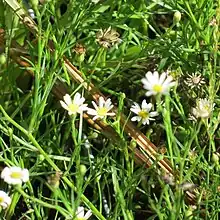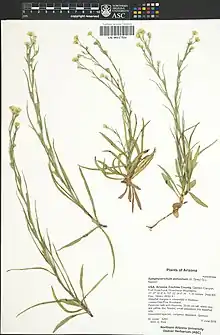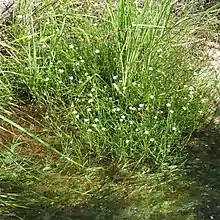Symphyotrichum potosinum
Symphyotrichum potosinum (formerly Aster potosinus) is a species of flowering plant in the family Asteraceae native to Mexico and the U.S. state of Arizona. Commonly known as Santa Rita Mountain aster,[3] it is a perennial, herbaceous plant that may reach heights of 15 to 45 centimeters (6 to 18 inches).
| Symphyotrichum potosinum | |
|---|---|
.jpg.webp) | |
| S. potosinum growing in Cochise County, Arizona, USA | |
| Scientific classification | |
| Kingdom: | Plantae |
| Clade: | Tracheophytes |
| Clade: | Angiosperms |
| Clade: | Eudicots |
| Clade: | Asterids |
| Order: | Asterales |
| Family: | Asteraceae |
| Tribe: | Astereae |
| Subtribe: | Symphyotrichinae |
| Genus: | Symphyotrichum |
| Subgenus: | Symphyotrichum subg. Astropolium |
| Species: | S. potosinum |
| Binomial name | |
| Symphyotrichum potosinum | |
 | |
| Native distribution[3][4] | |
| Synonyms[2] | |
| |
Description

Symphyotrichum potosinum is a perennial, herbaceous plant which blooms June to September. It grows from 15 to 45 centimeters (6 to 18 inches) in height, and can be either clump-forming or colonial with rhizomes in its root system. It has from one to three hairless or mostly hairless stems arising from the root base in an ascending or erect fashion. The stems are green but sometimes purple or purplish-brown. Although hairless or nearly so, the stems do have a small amount of hair at the axils where the leaves meet the stems.[3]
Leaves
The leaves are thin and grass-like, hairless or nearly so. Those at the base have long, sheathing, sparsely ciliate petioles, and they are from 4 to 11 cm (1.6 to 4.3 in) in length and usually 5–7 millimeters in width. By the time the plant flowers, the basal leaves are usually withered, yet the stem leaves usually remain. The leaves along the stem range in length from 5 to 12 cm (2 to 5 in) and sometimes up to 18 cm (7 in). They are also grass-like and typically not as wide as those at the base, with width measurements from 1–6 mm. The leaves highest on the stem are either grass-like or awl-shaped with a tapering point, shorter from 1 to 5 cm (0.4 to 2.0 in), and very thin at only 1–2 mm wide.[3]
Flowers
.jpg.webp)
The inflorescences of S. potosinum consist of a usual range of 3 to 20 flower heads in paniculiform arrays with their branches growing at 45–50° angles to the stem. Each head has a 1–4 cm (0.4–1.6 in) hairless peduncle with 1–4 bracts. The involucres are cylindric to hemispheric in shape and 5–7.3 mm in length. The phyllaries are in 2–3, sometimes up to 5, series, and awl-shaped to lanceolate.[3]
Its flowers have 14–27 white ray florets that are from 4.6 to 10.3 mm in length and 1.3–2 mm wide. There are usually 18–35 yellow disk florets with triangular spreading lobes when they bloom.[3]
Chromosomes
Symphyotrichum potosinum has a base number of five chromosomes (x = 5)[5] with a diploid count of 10.[3]
Taxonomy
History and classification

The basionym (original scientific name) of Symphyotrichum potosinum is Aster potosinus A.Gray.[6] Its name with author citations is Symphyotrichum potosinum (A.Gray) G.L.Nesom.[2] The species was formally described in 1880 by American botanist Asa Gray from a specimen collected by E.Palmer and C.C.Parry,[lower-alpha 1] now the holotype and housed in the Gray Herbarium.[11] It is a member of the genus Symphyotrichum classified in the subgenus Astropolium.[12]
Etymology
The word Symphyotrichum has as its root the Greek symphysis, which means "junction", and trichos, which means "hair".[13] The specific epithet potosinum is a Latinization of the Spanish word potosino for the Mexican state of San Luis Potosí where the holotype was found.[14]
The species' former genus, Aster, comes from the Ancient Greek word ἀστήρ (astḗr), meaning "star", referring to the shape of the flower. The word "aster" was used to describe a star-like flower as early as 1542 in De historia stirpium commentarii insignes, a book by the German physician and botanist Leonhart Fuchs. An old common name for Astereae species using the suffix "-wort" is "starwort", also spelled "star-wort" or "star wort". An early use of this name can be found in the same work by Fuchs as Sternkraut, translated from German literally as "star herb" (Stern Kraut).[15]
Distribution and habitat

Santa Rita Mountain aster is native to Arizona and Mexico. As of October 2021, it is known in the United States only from Cochise County, Arizona.[1] In Mexico, it has a recorded presence in the states of Aguascalientes, Chihuahua, Durango, Guanajuato, Guerrero, Hidalgo, Jalisco, México, Michoacan, Oaxaca, Puebla, San Luis Potosí, Sonora, Veracruz, and Zacatecas.[4] It is a wetland species and grows in muddy and wet soils on stream banks in the mountains at elevations of 1,500–1,900 meters (4,900–6,200 feet).[3]
Conservation
NatureServe lists Symphyotrichum potosinum as Imperiled (G2) worldwide, and Critically Imperiled (S1) in Arizona. The species is extirpated from the Santa Rita Mountains and possibly the Chiricahua Mountains. It is threatened by road maintenance, recreation, and habitat and water supply destruction. Its global status was last reviewed by NatureServe on 15 December 2015. The species' status in Mexico is not given.[1]
Notes
- British-American botanists Edward Palmer[7][8] and Charles Christopher Parry[9][10]
Citations
- NatureServe (2021).
- POWO (2021).
- Brouillet et al. (2006).
- Hassler (2021).
- Semple (n.d.).
- IPNI (2022).
- IPNI (2022b).
- Stafleu & Cowan (1979), p. 28–29.
- IPNI (2022c).
- Stafleu & Cowan (1979), p. 79.
- IPNI (2022a).
- Semple, Heard & Brouillet (2002), p. 133.
- Brouillet et al. (2006a).
- Gray (1880).
- Fuchs (1542).
References
- Brouillet, L.; Semple, J.C.; Allen, G.A.; Chambers, K.L.; Sundberg, S.D. (2006). "Symphyotrichum potosinum". In Flora of North America Editorial Committee (ed.). Flora of North America North of Mexico (FNA). Vol. 20. New York and Oxford: Oxford University Press. Retrieved 7 July 2021 – via eFloras.org, Missouri Botanical Garden, St. Louis, MO & Harvard University Herbaria, Cambridge, MA.
- Brouillet, L.; Semple, J.C.; Allen, G.A.; Chambers, K.L.; Sundberg, S.D. (2006a). "Symphyotrichum". In Flora of North America Editorial Committee (ed.). Flora of North America North of Mexico (FNA). Vol. 20. New York and Oxford: Oxford University Press. Retrieved 31 October 2022 – via eFloras.org, Missouri Botanical Garden, St. Louis, MO & Harvard University Herbaria, Cambridge, MA.
- Fuchs, L. (1542). De historia stirpium commentarii insignes (in Latin). Illustrated by Meyer, A.; Füllmaurer, H.; and Speckle, V.R. Basel, Switzerland: In officina Isingriniana. p. 133. Retrieved 3 January 2021 – via Biodiversity Heritage Library.
- Gray, A. (1880). "Botanical contributions". Proceedings of the American Academy of Arts and Sciences. new ser. v. 7. Boston: Metcalf and Co. 15: 32. ISSN 0199-9818. LCCN sf86003040. OCLC 1479254. Retrieved 31 October 2022 – via Biodiversity Heritage Library.
- Hassler, M. (17 March 2021). "Symphyotrichum potosinum (A. Gray) G. L. Nesom". In Roskov, Y.; Ower, G.; Orrell, T.; Nicolson, D.; Bailly, N.; Kirk, P.M.; Bourgoin, T.; DeWalt, R.E.; Decock, W.; van Nieukerken, E.J.; Penev, L. (eds.). Species 2000 & ITIS Catalogue of Life, 10 June 2021. ISSN 2405-8858. Retrieved 8 August 2021.
{{cite book}}:|journal=ignored (help) - IPNI (2022). "Symphyotrichum potosinum (A.Gray) G.L.Nesom". International Plant Names Index (IPNI). Royal Botanic Gardens, Kew; Harvard University Herbaria & Libraries; Australian National Botanic Gardens. Retrieved 31 October 2022.
- IPNI (2022a). "Aster potosinus A.Gray". International Plant Names Index (IPNI). Royal Botanic Gardens, Kew; Harvard University Herbaria & Libraries; Australian National Botanic Gardens. Retrieved 31 October 2022.
- IPNI (2022b). "Edward Palmer (1831–1911)". International Plant Names Index. Royal Botanic Gardens, Kew; Harvard University Herbaria & Libraries; Australian National Botanic Gardens. Retrieved 31 October 2022.
- IPNI (2022c). "Charles Christopher Parry (1823–1890)". International Plant Names Index. Royal Botanic Gardens, Kew; Harvard University Herbaria & Libraries; Australian National Botanic Gardens. Retrieved 31 October 2022.
- NatureServe (2 October 2021). "Symphyotrichum potosinum Santa Rita Mountain American-aster". explorer.natureserve.org. Arlington, Virginia. Retrieved 28 October 2021.
- POWO (2021). "Symphyotrichum potosinum (A.Gray) G.L.Nesom". Plants of the World Online. Royal Botanic Gardens, Kew. Retrieved 28 October 2021.
- Semple, J.C. (n.d.). "Symphyotrichum subg. Astropolium". www.uwaterloo.ca. Ontario. Archived from the original on 5 August 2021. Retrieved 5 August 2021.
- Semple, J.C.; Heard, S.B.; Brouillet, L. (2002). "Cultivated and native asters of Ontario (Compositae: Astereae)". University of Waterloo Biology Series. 41: 1–134.
- Stafleu, F.A.; Cowan, R.S. (1979). Taxonomic Literature : a Selective Guide to Botanical Publications and Collections with Dates, Commentaries and Types. Vol. 4 [P–Sak] (2nd ed.). Utrecht: Bohn, Scheltema & Holkema. Retrieved 1 September 2021 – via Biodiversity Heritage Library.
